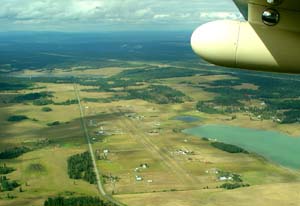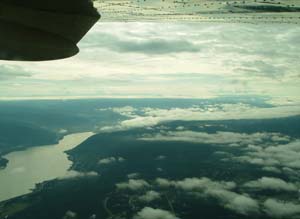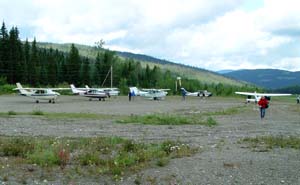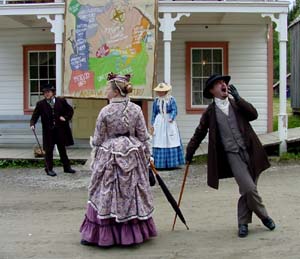Rested and ready to go, the flight to Springhouse (CAQ4) was a casual short hop. The sky was still peppered with clouds and an occasional rain shower.
 Springhouse airfield, is a 4800 ft long grass strip. Along the side were the usual assortment of houses, aircraft and non aircraft related businesses. An occasional small hangar or a row of T-hangars told of the good and bad times
at this airstrip. Quite a few planes or aircraft skeletons stood around with tall grass growing under their wings. As there was a nice lake adjacent to the runway, a few floatplanes were sitting in the grass waiting to be taken to the jetty. Our plane was parked at an empty spot protected from the wind by a low hangar. To fasten it again we used our sturdy pegs. Several other members of the FlyNorth group had already arrived and checked in at a lodge a few miles down the road. We met them on the porch of the restaurant sipping beer and checking out each other. We picked up our special FlyNorth mosquito outfit and had some more paperwork to sign, without which we probably could not complete the trip.
Springhouse airfield, is a 4800 ft long grass strip. Along the side were the usual assortment of houses, aircraft and non aircraft related businesses. An occasional small hangar or a row of T-hangars told of the good and bad times
at this airstrip. Quite a few planes or aircraft skeletons stood around with tall grass growing under their wings. As there was a nice lake adjacent to the runway, a few floatplanes were sitting in the grass waiting to be taken to the jetty. Our plane was parked at an empty spot protected from the wind by a low hangar. To fasten it again we used our sturdy pegs. Several other members of the FlyNorth group had already arrived and checked in at a lodge a few miles down the road. We met them on the porch of the restaurant sipping beer and checking out each other. We picked up our special FlyNorth mosquito outfit and had some more paperwork to sign, without which we probably could not complete the trip.
Having packed and unpacked some of our belongings a few times now, we realized that we had to make further reductions to make our trip more practical. A new evaluation round passed through our bags and surprise, we managed to eliminate quite a load which did not affect us that much in weight but more in space. From now on loading and unloading became considerably easier, however, there was still a neat stack of "need to have along" items that went in and out of our Centurion. Of course all had to be loaded into a taxi or courtesy car each time we checked in for the night and back in the morning. Important for us was that we were happy. All that excess stuff we eliminated is now sitting in a corner of Lawrence Aviation hoping to be picked up by us one day, or maybe we will have it boxed up and sent back by UPS.
 The
day after our arrival was Saturday. It was the trial run for coordinating our FlyNorth ballet exercises, addressing such questions as to "who goes first," "how do we communicate," how do we avoid running into each other," "who is making decisions," etc..
? The assignment was to fly 40 minutes to the old mining town of Barkerville (CAS3) having a 2700 ft paved runway which allows approach and departure from just one side. Everyone just seemed to sit around waiting for the start signal from John Dale, the organizer from FlyNorth. Nothing happened. We were ready to go but nobody did. So we took the initiative, went to the plane and started the engine. The first lesson was about to be learned. Prior to take off we had to backtrack on the runway and it had a nasty hump about half way to the end so that one could not see what was going on at the departure end observed from the run-up position. Since we were so far ahead, we took off after announcing our intentions while the rest of the group, having started to move also, had to wait briefly before jointly taxiing to the starting line.
The
day after our arrival was Saturday. It was the trial run for coordinating our FlyNorth ballet exercises, addressing such questions as to "who goes first," "how do we communicate," how do we avoid running into each other," "who is making decisions," etc..
? The assignment was to fly 40 minutes to the old mining town of Barkerville (CAS3) having a 2700 ft paved runway which allows approach and departure from just one side. Everyone just seemed to sit around waiting for the start signal from John Dale, the organizer from FlyNorth. Nothing happened. We were ready to go but nobody did. So we took the initiative, went to the plane and started the engine. The first lesson was about to be learned. Prior to take off we had to backtrack on the runway and it had a nasty hump about half way to the end so that one could not see what was going on at the departure end observed from the run-up position. Since we were so far ahead, we took off after announcing our intentions while the rest of the group, having started to move also, had to wait briefly before jointly taxiing to the starting line.
The sky was littered with clouds 3-4000 ft AGL and the first leg was uneventful. We stayed in contact with the group on the "company frequency" 123.45 and reported what was behind the first bank of clouds and fog. The flight was somewhat like being the ball in a pinball machine, especially when the rolling hills got higher and the clouds came lower. The briefing on the approach (come in across the lake to the West at 1000 AGL and at the Eastern end turn 90 degrees around the hill and there is the runway) John had given us was a great help and we reported our proceedings to the group following a few minutes behind us sparing them an overhead investigation among hills and clouds. -- Having taken the initiative has labeled us as a couple with a tendency to stand out in the crowd. Not everybody appreciates such behavior
as we could notice later on.
 The one mile walk to the old mining town of Barkerville was a good exercise and several attempts to hitch a ride failed. The historic town was one illustrious assortment of houses, shops, restaurants and museum facilities. All the employees were dressed in the 1890 style and some performed amusing presentations of historical and social events. The town was one of the first in the Gold Rush around 1860. Many of the buildings and items displayed were from that time. Especially noteworthy was the large community of Chinese miners and workers. Apparently smoking Opium was a widespread habit in those days before it was prohibited.
The one mile walk to the old mining town of Barkerville was a good exercise and several attempts to hitch a ride failed. The historic town was one illustrious assortment of houses, shops, restaurants and museum facilities. All the employees were dressed in the 1890 style and some performed amusing presentations of historical and social events. The town was one of the first in the Gold Rush around 1860. Many of the buildings and items displayed were from that time. Especially noteworthy was the large community of Chinese miners and workers. Apparently smoking Opium was a widespread habit in those days before it was prohibited.
 A hearty late miner's breakfast, laid the foundation for the day. Making our tour, with one eye we enjoyed the many attractions of the town and with the other we watched the sky as the clouds became darker and kept coming lower and started to settle on the mountains around us. A little later in the afternoon we found ourselves in good company making our way back to the aircraft parking area, which resembled more a gravel quarry than a ramp. Taking due consideration to keep our RPM as low as possible while on the gravel, then taking off to the open end of the valley, posed to be no problem. We had been briefed about the various impact points on the hillside of unsuccessful departure attempts, of pilots who had tried to make it up the valley.
A hearty late miner's breakfast, laid the foundation for the day. Making our tour, with one eye we enjoyed the many attractions of the town and with the other we watched the sky as the clouds became darker and kept coming lower and started to settle on the mountains around us. A little later in the afternoon we found ourselves in good company making our way back to the aircraft parking area, which resembled more a gravel quarry than a ramp. Taking due consideration to keep our RPM as low as possible while on the gravel, then taking off to the open end of the valley, posed to be no problem. We had been briefed about the various impact points on the hillside of unsuccessful departure attempts, of pilots who had tried to make it up the valley.
A little over half an hour later several of our group arrived back at Springhouse. It was interesting to see the different interpretations on the option in which direction to land. The choice was either a light tail wind and landing uphill or properly into the wind and landing downhill. Later that day also the rest of the group arrived back at Springhouse. One had the privilege to put his plane down after a heavy rain had soaked the grass strip and
have it plaster a major part of his aircraft with local dirt and grass. However, in the evening all of us met happily for the BBQ in the warm hangar with a lot to talk about.